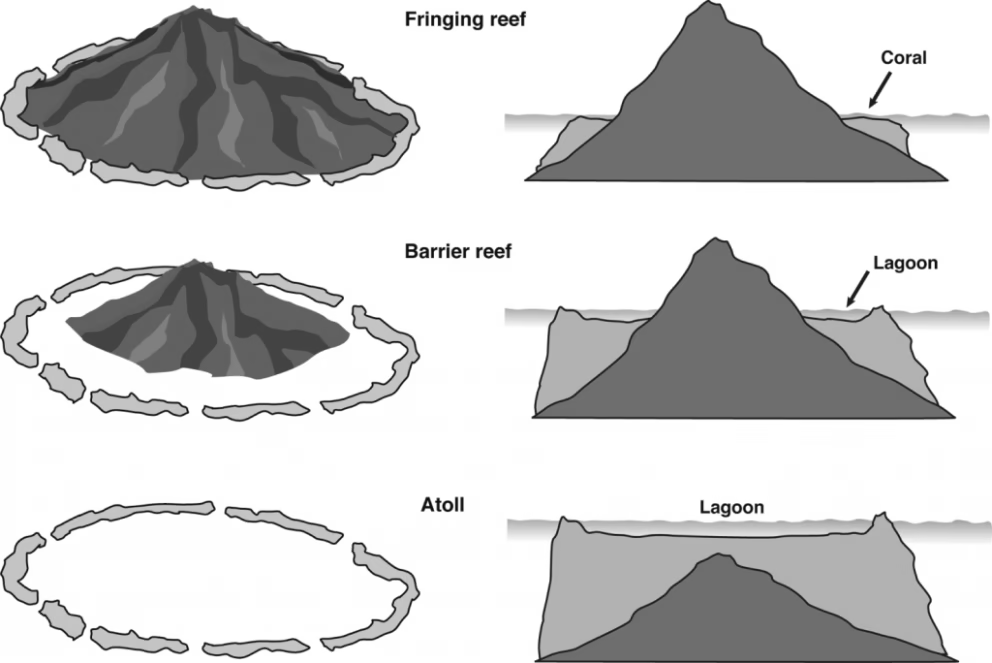What are Coral Reefs?
- Coral colonies grow continuously in size by budding of polyps and often form extensive masses, known as coral reefs.
- According to T. Wayland Vaughan (1917), A coral reef is a ridge or mound of limestone, the upper surface of which is near the surface of sea and which is formed chiefly of CaCO3 secreted by coral polyps.
- Principal builders of coral reefs are stony corals (Madreporaria), but other important contributors are the hydrocorallines and alcyonarians.
- Coralline algae and Foraminiferan Protozoa also take part in the formation of coral reefs.
- Reef building corals require warm shallow waters (normally above 20oC).
- They are therefore limited to the Indo-Pacific, the Central-Western Pacific, and the Caribbean regions north of Bermuda.
- About 50 species of corals contribute in the formation of reefs along the Florida keys and in the West-Indies.
Types of coral reefs
- The coral reefs are of three kinds, depending on how they are formed:-
1. Fringing reefs
- Coral reefs lying close to the shores of some volcanic island or part of some continent are termed fringing reefs.
- A fringing reef may extend out to a distance of a quarter mile from the shore with the most active zone of the coral growth facing the sea.
- This seaward zone is commonly called the edge or front.
- A shallow water channel, 50 to 100 meters broad, lies between the reef-edge and shore.
- At low tide, water of channel recedes at quickly exposing a flat bottom surface, called reef flat.
- It is largely composed of coral sand, mud, dead and living coral colonies and other animals.
2. Barrier reefs
- Barrier reefs are like fringing reefs but they are located some distance away from the shore.
- The stretch of water, separating the barrier reef from land, may be half a mile to 10 miles or more in width. It is called a lagoon.
- It is 10 to 50 fathoms deep and suitable for navigation.
- Most notable example of barrier reef is the Great Barrier Reef along the North-eastern coast of Australia.
- It is about 2,000km long and up to 150 km from shore.
3. Atoll
- An atoll is also termed a coral island or lagoon island.
- It is a ring-like or horse-shoe-shaped reef that encircles a lagoon but not an island.
- The lagoon varies from a few to about 90km across.
- It may be complete or broken by a number of channels, of which only a few are navigable.
- Outer side of the reef slopes off rather steeply into the depth of ocean.
- The atoll of Bikini, famous for atomic and hydrogen bomb tests, lies in the Pacific Ocean.

Formation of coral reefs
- Many theories have been advanced to explain coral-reef formation, but none are entirely satisfactory.
- Two theories seem to be of some convincing importance:-
(a) Subsidence theory by Darwin
- According to this theory, as put forth by Darwin (1831), fringing reef was first formed on the sloping shore of an island.
- Subsidence of sea-floor then commenced in the regions of reef followed by upward and outward growth of coral.
- Thus, the fringing reef became the barrier reef.
- By gradual sinking the island ultimately vanished and the barrier reef became a coral atoll with a central lagoon.
- In time it acquired a growth of vegetation.
(b) Glacial-control theory by Daly
- Another theory, as propounded by Daly, accounts for the lowering of the ocean level by the withdrawal of water for glacial formation.
- This resulted in the exposing of several flat platforms cut out by the action of waves.
- When the glaciers melted and the temperature became favorable, corals began to grow on these platforms, building higher as the ocean level rose.
- Most reefs grew at the rate of 10-200 mm each year.
- Most of the exciting reefs could have formed with in a period of 15,000 to 30,000 years.
Economic importance of coral reefs
- Corals of the remote geological past formed reef structures that were highly favourable sites for the accumulation of petroleum deposits.
- Thus, coral reefs are of much importance to oil industry.
- Large quantities of corals are shipped every year for the curio trade.
- The coral reefs serve as habitats for many plants and animals like sponges, molluscs, echinoderms, fishes, etc.
- Some coral reefs are used as habitations by man as well.
- Some corals are highly priced for their decorative value.
- Corallum rubrum is considered to be a precious stone in India and China and treated as auspicious.
- The red coral and organ pipe coral are used in some indigenous system of medicine in S. India.
- Chunks of coral skeleton belonging to species Porites are used as building material.
- Coral skeletons serve as raw material for the preparation of lime, mortar and cement because of their calcium carbonate and magnesium carbonate content.
- Coral skeletons are also helpful in making ridges that may act as natural barriers against sea erosion and cyclonic storms.
- Coral reefs serve as good nursery grounds for commercially important fishes.
- Reef fish varieties are more colorful than others.